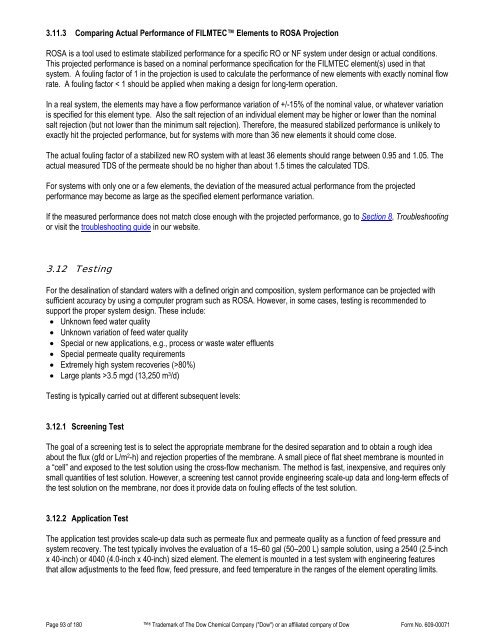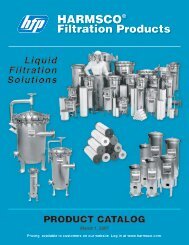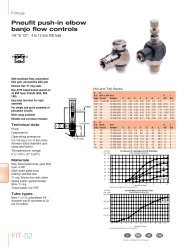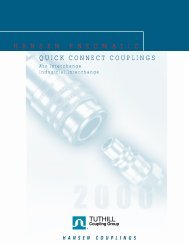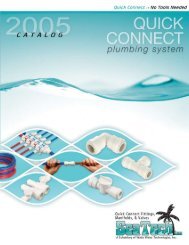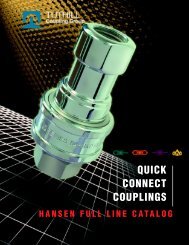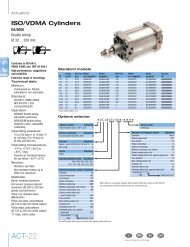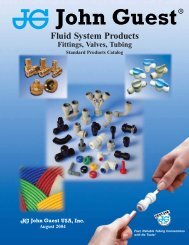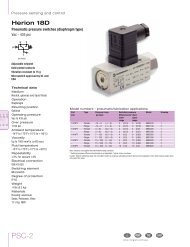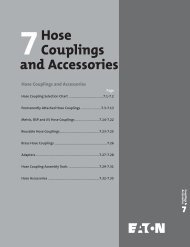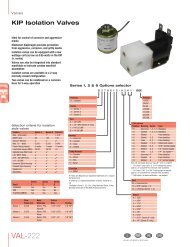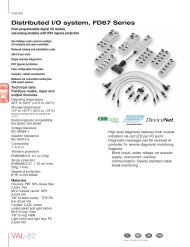FilmTec Technical Manual - Chester Paul Company
FilmTec Technical Manual - Chester Paul Company
FilmTec Technical Manual - Chester Paul Company
You also want an ePaper? Increase the reach of your titles
YUMPU automatically turns print PDFs into web optimized ePapers that Google loves.
3.11.3 Comparing Actual Performance of FILMTEC Elements to ROSA ProjectionROSA is a tool used to estimate stabilized performance for a specific RO or NF system under design or actual conditions.This projected performance is based on a nominal performance specification for the FILMTEC element(s) used in thatsystem. A fouling factor of 1 in the projection is used to calculate the performance of new elements with exactly nominal flowrate. A fouling factor < 1 should be applied when making a design for long-term operation.In a real system, the elements may have a flow performance variation of +/-15% of the nominal value, or whatever variationis specified for this element type. Also the salt rejection of an individual element may be higher or lower than the nominalsalt rejection (but not lower than the minimum salt rejection). Therefore, the measured stabilized performance is unlikely toexactly hit the projected performance, but for systems with more than 36 new elements it should come close.The actual fouling factor of a stabilized new RO system with at least 36 elements should range between 0.95 and 1.05. Theactual measured TDS of the permeate should be no higher than about 1.5 times the calculated TDS.For systems with only one or a few elements, the deviation of the measured actual performance from the projectedperformance may become as large as the specified element performance variation.If the measured performance does not match close enough with the projected performance, go to Section 8, Troubleshootingor visit the troubleshooting guide in our website.3.12 TestingFor the desalination of standard waters with a defined origin and composition, system performance can be projected withsufficient accuracy by using a computer program such as ROSA. However, in some cases, testing is recommended tosupport the proper system design. These include:• Unknown feed water quality• Unknown variation of feed water quality• Special or new applications, e.g., process or waste water effluents• Special permeate quality requirements• Extremely high system recoveries (>80%)• Large plants >3.5 mgd (13,250 m 3 /d)Testing is typically carried out at different subsequent levels:3.12.1 Screening TestThe goal of a screening test is to select the appropriate membrane for the desired separation and to obtain a rough ideaabout the flux (gfd or L/m 2 -h) and rejection properties of the membrane. A small piece of flat sheet membrane is mounted ina “cell” and exposed to the test solution using the cross-flow mechanism. The method is fast, inexpensive, and requires onlysmall quantities of test solution. However, a screening test cannot provide engineering scale-up data and long-term effects ofthe test solution on the membrane, nor does it provide data on fouling effects of the test solution.3.12.2 Application TestThe application test provides scale-up data such as permeate flux and permeate quality as a function of feed pressure andsystem recovery. The test typically involves the evaluation of a 15–60 gal (50–200 L) sample solution, using a 2540 (2.5-inchx 40-inch) or 4040 (4.0-inch x 40-inch) sized element. The element is mounted in a test system with engineering featuresthat allow adjustments to the feed flow, feed pressure, and feed temperature in the ranges of the element operating limits.Page 93 of 180 ® Trademark of The Dow Chemical <strong>Company</strong> ("Dow") or an affiliated company of Dow Form No. 609-00071


